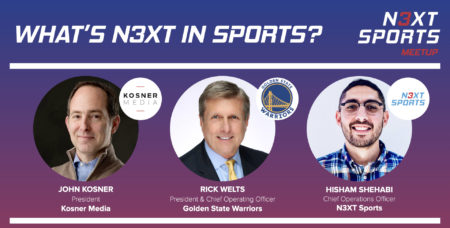
What’s N3XT in Sports?
¨The Oracle Arena, our old arena, was a wonderful atmosphere to play games, but it didn’t support what the financial structure for our industry was going to expect if we’re going to be successful long term¨ – Rick Welts
¨One of the things that is going to be a result of COVID is a real appreciation of the importance of fans and the best teams are going to really enhance the service and develop more things for fans¨ – John Kosner
Changing consumer behaviors have disrupted sports entities around the world, and COVID has accelerated and uncovered some of the structural weaknesses within the sports industry. Moving from a B2B to a D2C (D2F – Direct to Fan) is upending sports entities, and the NBA has shown its leadership in this space as well.
For our 16th online Meetup entitled What’s N3XT in Sports?, we had the pleasure of jumping into topics close to our work with two respected executives from the world of basketball, technology & innovation: Rick Welts, President & COO of the Golden State Warriors, and John Kosner, President of Kosner Media. Read on for some high-level summary points, and we would encourage you to watch the whole recording here if you did not have the chance to attend the session.
Got an innovation, digital & tech strategy, or investment thesis you’re looking to validate with one of our experts? Let us know, by emailing our colleague javier@n3xtsports.com to find out more about how our team can get you going in the right direction.
Importance of arena infrastructure
The Golden State Warriors were playing in one of the oldest arenas in the NBA, and in September 2019, they opened the Chase Center, a privately financed $1.6 billion facility in San Francisco. Thanks to the new, and very sophisticated arena, they are able to implement new technology that will help bring fans to the arena next season, and will enhance the fan experience on site.
¨Technology is going to help us get people back into our arena. In our business model, about 60% of our revenue is derived by the actual sale of tickets and what people do in our arenas while we’re there. Our business model doesn’t work if we can’t get fans back into our units, and obviously technology is gonna play a huge role in being able to do that.¨

The commercial opportunities that the new arena brings gives a new impetus to the already-successful commercial and partnerships program in place by the Warriors. The importance of technology in this equation is only outweighed by the consumer and their expectations, which is always changing.
¨We did not want to use technology just for the sake of it, it had to serve a purpose and we wanted to use the technology to enhance the fan experience in the arena. The level of expectation of the fans is extremely high and we have a lot of great partners who helped us make sure that the WiFi and data system installed at Chase Center could meet the demands of the fans.¨ – Rick Welts
Changes in the sports industry due to COVID
With the speakers, we deep-dived into some COVID-triggered changes that will likely outlast the pandemic situation.
The importance of the fan and the enhanced fan experience were underlined as was the use of more technology such as AI and cloud computing, and wearable technology that can predict injuries and potential illnesses are going to increase in popularity.
¨With many leagues being played behind doors, we are going to see the expansion of more sort of watch party type technology allowing groups at a distance to watch a sporting event while also communicating with each other.¨

¨For us, we’re finally moving to completely touchless transactions and moving to completely mobile ticketing. So the experience that people have when they come back is going to be much different in the experience they had even four months ago when we’re playing basketball games.¨ – Rick Welts
The COVID-19 crisis has accelerated the digital transformation journey for many sports organizations and only those who already had a digital foundation before COVID were able to create a competitive advantage among the rest of them.
Working with the ecosystem
More and more often, sports organizations are seeing the value in working with their ecosystem to find solutions that they cannot develop internally and this can go from big corporations to early-stage startups.
John and the late NBA Commissioner Emeritus David Stern created Micromanagement Ventures, a portfolio of sports technology start-ups focused on media, betting and player health. Throughout the session, John was able to share with us so many great examples of how startups can provide solutions to big organizations such as the NBA:
The NBA and Micromanagement Ventures invested in a startup called WSC Sports, a company out of Tel Aviv that has revolutionized the creation and distribution of sports video highlights by using AI technologies, such as computer vision and machine learning. WSC Sports machine learning can analyze a piece of data so it knows who Steph Curry is, it knows who Draymond Green is. You can set some guide rules, and it will automatically generate the best highlights of these players. It can be distributed simultaneously over the world to multiple different networks. The NBA took an investment position in the company early and then they tested them through the WNBA and G League, and so they were able to figure out and help WSC improve the product. Now the NBA uses it with all the NBA teams.
In previous online Meetups, we have heard how women’s football and youth football is a great landscape to try out new initiatives and new technologies. During the session, we heard how the WNBA and the NBA Development League, which is now known as the G league sponsored by Gatorade have become great places to test new products before using them on the NBA.
New opportunities
Esports is an industry that has grown exponentially in the past few years, but during the pandemic has gained all the attention from sports organizations to professional athletes to brands and fans.
¨Esports is a way to reach out to younger audiences, and to create a nexus between fans and athletes. Through esports there’s a level of interaction and engagement. That’s real brand new and developing and a place where I believe sports can be in the center and benefit from¨ – John Kosner
Many partnership activations have fallen apart because of the lack of sporting events, but for a team like the Golden State Warriors who has an esports team, they were able to fulfill some of those partnerships obligations by moving some of the assets that they would have delivered with the Warriors basketball team into some of its esports activities, whether it was NBA 2K or League of Legends teams.
Players as investors
Last year, we published the 2019 Trends in Sports Technology Report where we commented on a trend called Athletes INC. Professional athletes are investors, advisors and influencers. Some examples are Steph Curry, and Andre Iguodala who have investments in sports technology companies. During the session, John shared with listeners how Rory McIlroy, a top golfer, is not only a user of the Whoop wearable product, but also one of the company investors, which gives him the ability to diversify his portfolio, but also to provide a validating voice to the company and its product through his own marketing channels and platforms.
¨Leagues and the sports industry, in general, has gotten more aggressive, individual players have gotten more aggressive and they are ambassadors for technology…they leverage their presence on social media with a unique influence.¨ – John Kosner
Partnership landscape
Rick shared how partnerships are no longer only about putting the brand name beside the Warriors logo, there needs to be a story behind the partnership and how, now more than ever, brands need to bring or add value to the sports organization by telling/showing what they do.
¨For brands now, there’s no limit to the sports marketing budget if they can deliver real value and move the needle on sales, marketing, whatever it is they’re trying to achieve. It’s an exhilarating time for the relationship between sports and corporate brands who now, more than ever see the value.¨ – Rick Welts



